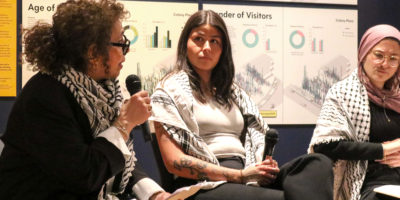By Siri Agrell
All great artists are confronted with the issue of selling out at some point during their career. Whether it’s an indie band signing on to a major label or a theatre star moving to Hollywood, money often wins out over independence. But for those who refuse to go commercial, the battle to survive can be overwhelming.
The Ryerson Gallery has been involved in this struggle since it started displaying the art of students, faculty, and alumni more than 10 years ago.
Although the gallery is located off-campus, it shares a space with 10 other galleries at 80 Spadina Ave.—it’s still a part of the university, and operates mainly as a showcase for image arts students. The university pays for the gallery’s rent and phone bills, but covering the operating costs is difficult because the gallery doesn’t charge admission or hanging fees for its exhibits. The gallery’s annual budget is just $30,000.
In the past, the gallery has considered sponsorships with private companies and sponsors, but they all come with strings attached.
“Most of the potential partners who’ve come forward want something in return,” said Don Snyder, the image arts professor who initiated the gallery project and ran it for the first three years of its existence. “They want recognition of they want authority over what’s shown.”
But those who have been involved with the gallery say the struggle is worthwhile as long as they can maintain their artistic integrity.
To keep it going over the years, Snyder has even contributed some of his own money, but he doesn’t believe corporate sponsors are a good idea.
“I would rather keep the gallery run on the cheap than get tied down in a relationship where our freedom is in jeopardy,” Snyder said.
Handing over control to private companies could potentially lead to censorship of student work if sponsors disapprove of their content. To Snyder, this option is not acceptable.
A year and a half after the gallery opened, he considered separating it from Ryerson so it could qualify for funding from the Ontario Arts Council. But he found that they too had a strict set of guidelines, and wanted to appoint a board of governors who would have ultimate control over the gallery’s content.
“With that structure we would have to book shows 18 months in advance—right now we’re flexible enough that we can give a talented student a last-minute show,” Snyder said. “The freedom alone is worth the constant struggle for funding.”
With corporate sponsorship ruled out, the gallery has had to look in other directions for help. Student volunteers and Bob Burley, the gallery’s current faculty coordinator, have spearheaded the initiative.
We’re still struggling to keep our heads above water and we’re constantly looking for new ways to fund the space,” Burley said.
Over the past year, they’ve started to gain some momentum. Last academic year, the faculty of applied arts contributed $1,200 to the gallery and they received an additional $9,100 from the Dean Track Fund, a Ryerson fund for undergraduate enhancement.
With the money, the gallery was given a facelift and a new computer for administrative and office duties. The gallery operators also bought a sound system and film projectors so they could widen the range of their shows by incorporating new media content.
But these improvements are not enough to sustain the space.
“There’s always a rally when things get dire, but we’re trying to go from short-term answers to long-term solutions,” Burley said. “We need to find yearly funding from a number of sources.”
To do this, Burley and a group of image arts students have dedicated their time to getting money for the gallery.
This year, the gallery hired three students as interns through OSAP’s work-study program, which pays students $10 an hour to supervise the gallery.
Dave Kemp, a fourth-year image arts student, received a work-study placement at the gallery. While he sees the program as helpful, he thinks more is needed.
“There’s a lot of minor things, incremental costs, that make it pretty hard to keep going,” Kemp said. “Our major fundraising has mostly been students and faculty going out and approaching people.”
This approach has been relatively successful. The gallery just received $4,500 from Howard and Carol Tanenbaum, private art collectors who are using their family foundation to sponsor an exhibit by Eugen Atget that will run in April.
The high-profile exhibit will be held in conjunction with the AGO’s curation and conversation course, and 25 image arts students will learn from gallery professionals how to install and maintain the exhibit.
“I think it’s an important part of our curriculum,” Burley said. “To have a professional gallery in a public space, it gives students hands-on experience on so many levels.”
He volunteered to run the gallery two years ago, and was released from some of his teaching responsibilities from the school of image arts to dedicate more time to the project.
“It would be a shame to lose [the gallery] as a result of time commitments,” he said. “[But now] I can concentrate more of my energy.”
Since it opened in November 1990, the Ryerson Gallery has been home to a lot of artistic energy. More than 300 volunteers have helped put on its eighth annual shows. The gallery has come close to shutting down on countless occasions, but has always been saved by last-minute fundraising blitzes.
“It’s the case with most arts organizations these days, so we’re not really surprised that we’ve run into problems,” Burley said.
But bothe Burley and Snyder agree that the gallery’s value to students is worth the financial hardships they must fight every year.
“As long as it’s still alive—that’s a good thing,” Bring said.










Leave a Reply